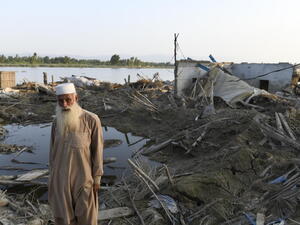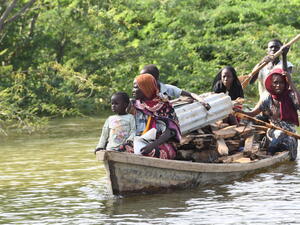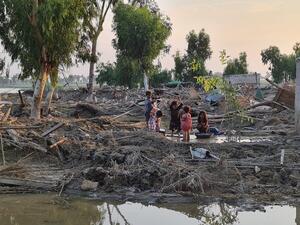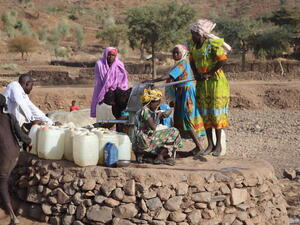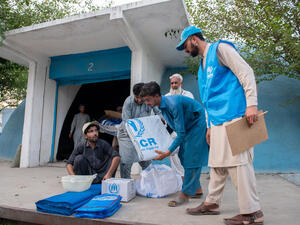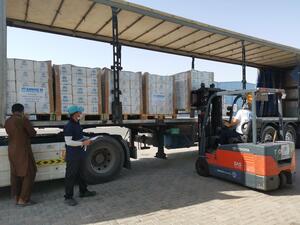As villages re-emerge from Pakistan's floods, residents still wait to go home
As villages re-emerge from Pakistan's floods, residents still wait to go home

Mohammad Achar, centre, talks to relatives about the destruction of his house in Pakistan's floods.
THATTA, Pakistan, October 29 (UNHCR) - Mohammad Achar stared in disbelief at what the flood waters had done to his rice fields, his only source of income for the year.
"Everything is destroyed," he said. "My crops, my home, my livestock. Everything." His village in Sind Province, about 150 kilometers from the port city of Karachi, is only now starting to emerge, but reaching it still required a 40 minute journey by boat from the nearest road. Now, he says, he is nervous about rebuilding. He has heard rumours that the flood waters could hit again.
Forty-year-old Mohammad is one of the thousands of flood victims in Sindh now living in transit camps recently established by UNHCR. The camps were created to house those displaced a second time when they were told to vacate schools where they had originally sought shelter after the floods drove them from their homes two months ago. Thousands of others are living in makeshift camps by roadsides and other high ground.
Achar who owns four acres of land, said the flood wiped out his earnings for the year, which he estimated at 500,000 Pakistani rupees, or nearly US$ 6,000.
Recalling the onset of the floods, Mohammad, a father of seven children, said he was in a local market when he heard that his village would be hit. "A day ahead of the floods, we managed to arrange a truck and found shelter in a school in another district. A month later, the government asked us to leave, saying the water levels in our area had receded."
The roads leading to his village had been washed away, Mohammad found as he sought to return. Rural areas remained cut off. Like thousands of others across the province, he and his family created a makeshift camp as near to home as possible. Recently, they moved into tents provided by UNHCR.
"Now we are living in these tents and we are quite happy as it is our own area. The school where we were living was very dirty but this is an open area, clean and well managed," he said.
About 70 families, or 250 people, now live in the Kundan camp. It is one of eight camps recently established by UNHCR to replace improvised settlements created by residents in the Jati area. With shelter in place, UNHCR and its partners are working to improve water, sanitation and other services. Ten new camps have been established further north and more are being constructed every week.
Unable to return home, many of those displaced by the floods choose instead to live as nearby as possible. "Closer to home, with their family and community around them, families are better able to cope," said Emmanuel Gignac, an Emergency Coordinator with UNHCR. "It's also easier for them to assess when the time is right to return. Then, they just pick up their tent and move."
Meanwhile Achar, one of the few people in his village to graduate from high school, is hoping to improve the quality of life in the camp. He has set aside two tents to make a school and plans to teach the camp's 50 children, though he lacks the resources to buy books, furniture or clothes for the students.
"I am teaching my children and I also want these other children to be educated," he said.
By Qaisar Khan Afridi and Ariane Rummery in Thatta, Pakistan

